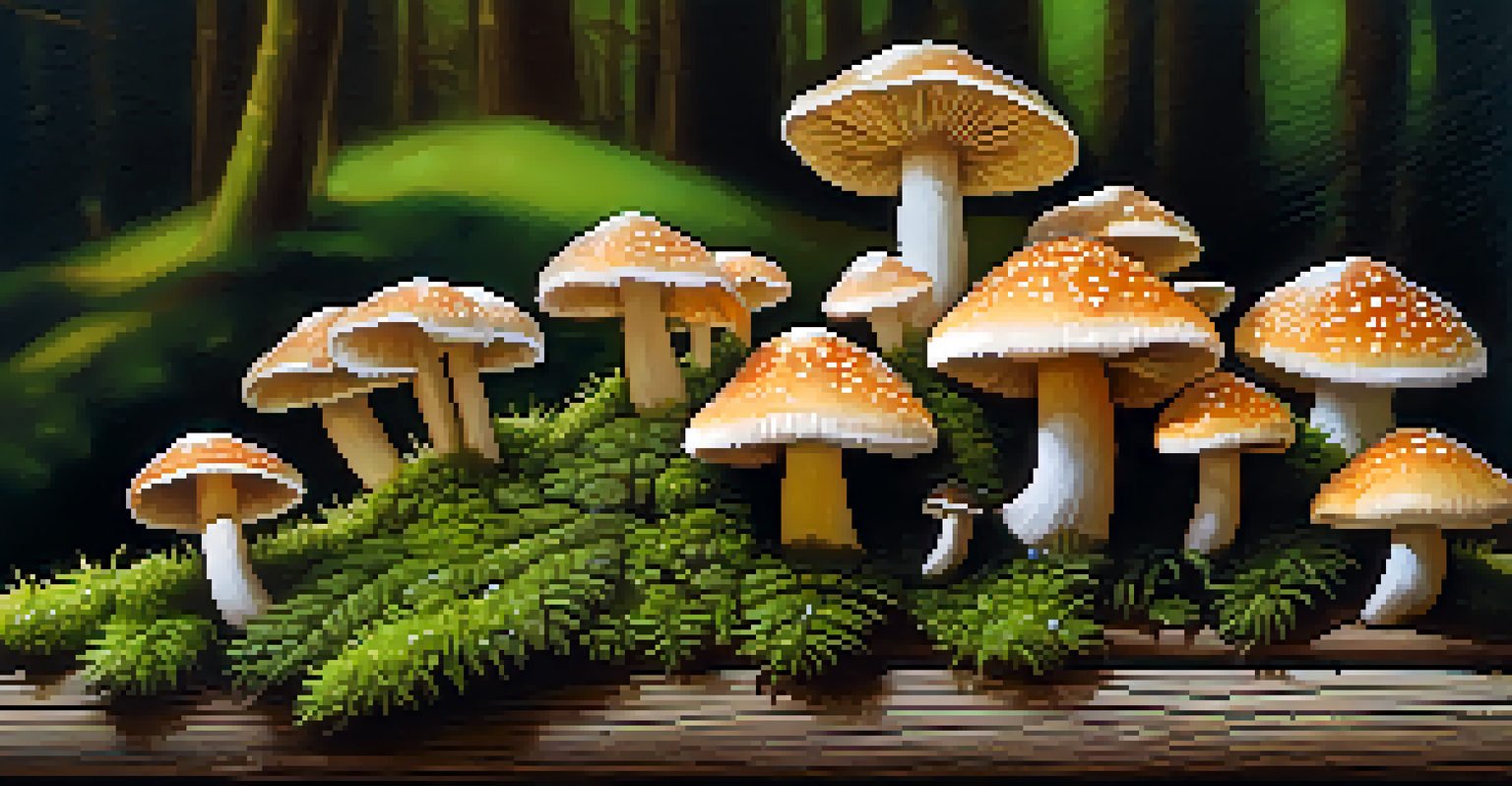The Science Behind Entheogens and Their Ritualistic Use

Understanding Entheogens: Nature’s Psychedelic Wonders
Entheogens are naturally occurring substances that alter perception and consciousness, often used in spiritual contexts. Common examples include psilocybin mushrooms and ayahuasca, which have been integral to various cultures for centuries. These substances are believed to facilitate deep introspection and connection with the divine, acting as catalysts for profound experiences.
The greatest discovery of my generation is that a human being can alter his life by altering his attitudes.
The term 'entheogen' itself means 'generating the divine within,' emphasizing their role in spiritual exploration. People often use these substances during ceremonies to enhance emotional well-being and foster personal growth. This connection between nature and spirituality highlights humanity's long-standing quest for meaning and understanding.
Scientific research has begun to uncover the mechanisms behind these substances, revealing how they interact with the brain. By affecting serotonin receptors, entheogens can lead to altered states of consciousness that allow for unique insights and experiences. This intersection of science and spirituality makes the study of entheogens particularly fascinating.
The Historical Context of Entheogen Use in Cultures
Entheogens have been utilized in various cultures throughout history, often revered as sacred tools for spiritual growth. Indigenous tribes in the Amazon have used ayahuasca for healing and divination, while ancient Greeks employed kykeon, a psychedelic beverage, in religious rituals. These practices underscore a deep-rooted belief in the transformative power of these substances.

In many societies, entheogens were not just for personal use; they were integral to communal events, bringing people together in shared spiritual experiences. This communal aspect fosters a sense of belonging and collective insight, which can be incredibly powerful for individuals. The rituals surrounding their use often include music, dance, and guided experiences, enriching the spiritual journey.
Entheogens and Spiritual Growth
Entheogens, like psilocybin and ayahuasca, are used in spiritual contexts to foster deep introspection and connection with the divine.
As we delve into the past, it's clear that these substances were often seen as a bridge to the divine. They allowed practitioners to transcend ordinary reality and connect with higher states of consciousness. This historical perspective provides valuable insight into how and why such practices have persisted into modern times.
Modern Scientific Research on Entheogens
Recent advancements in neuroscience have sparked renewed interest in the study of entheogens and their profound effects on the human mind. Researchers are exploring how these substances can promote neuroplasticity, which is the brain's ability to form new connections. This could lead to innovative treatments for mental health issues such as depression and PTSD.
Nature is not a place to visit. It is home.
Studies have shown that psilocybin, for instance, can produce significant and lasting changes in mood and perspective, even after just a few sessions. This has opened up conversations about the therapeutic potential of entheogens, challenging traditional views on mental health treatments. The idea that these natural substances could be used to heal psychological wounds is both exciting and revolutionary.
Furthermore, the integration of these substances into therapeutic settings often involves careful guidance and support, emphasizing safety and intention. This approach contrasts with recreational use, highlighting the importance of context in deriving meaningful benefits from entheogenic experiences. As research continues, we may witness a paradigm shift in how we understand mental health and wellness.
Rituals: The Heart of Entheogenic Experiences
Rituals play a crucial role in the use of entheogens, setting the stage for transformative experiences. These ceremonies often involve specific practices, including prayers, chants, and the presence of a facilitator or shaman. Such elements help create a safe space where participants can explore their consciousness without fear or distraction.
The structure of these rituals can vary widely across cultures but generally emphasizes intention and reverence for the substances being used. This preparation helps individuals focus on their inner journey, allowing for deeper insights and emotional healing. Participants often report feeling a strong connection to others and to something greater than themselves during these experiences.
Therapeutic Potential of Entheogens
Research shows that entheogens can promote neuroplasticity and provide significant relief for mental health issues such as depression and PTSD.
Additionally, the aftermath of these rituals is just as important as the experience itself. Many participants engage in integration sessions to process their insights and apply them in their daily lives. This holistic approach reinforces the idea that entheogens are not just substances to be consumed; they are tools for personal and communal growth.
Healing Potential: Entheogens and Mental Health
The therapeutic potential of entheogens has garnered significant attention in recent years, particularly in addressing mental health challenges. Preliminary research suggests that these substances can lead to rapid relief from depression, anxiety, and addiction. This offers hope for individuals who have struggled to find effective treatments within traditional frameworks.
One of the most compelling aspects of entheogenic therapy is the way it can facilitate profound personal insights. Participants often describe experiencing a sense of clarity and understanding regarding their emotions and behaviors. This newfound perspective can empower individuals to tackle their mental health challenges head-on, fostering resilience and growth.
However, it’s essential to approach this area with caution and respect. While the potential is immense, not all experiences are positive, and the context of use is critical. Professional guidance and safe environments are key to ensuring that the healing process is both effective and supportive.
Navigating Legal and Ethical Considerations
As the interest in entheogens grows, so do the discussions surrounding their legal status and ethical implications. Many countries have strict regulations regarding their use, often classifying them as illegal substances. This creates a complex landscape for researchers and practitioners aiming to explore their potential benefits responsibly.
In recent years, some regions have begun to reconsider these laws, recognizing the potential therapeutic benefits of entheogens. For instance, cities like Denver and Oakland have decriminalized the use of psilocybin mushrooms, paving the way for more open discussions and research opportunities. However, navigating these changes requires careful consideration of safety, ethics, and accessibility.
Importance of Rituals in Use
Rituals surrounding entheogenic experiences create a safe environment that enhances emotional healing and personal growth.
Ethically, it's crucial to approach the use of entheogens with respect for the cultures that have traditionally used them. This includes acknowledging the spiritual significance and ensuring that practices are not appropriated without understanding or consent. By fostering an ethical framework, we can honor the rich history of entheogens while exploring their modern applications.
The Future of Entheogens in Society and Spirituality
As we look ahead, the future of entheogens in both society and spirituality appears promising yet complex. With increasing acceptance and interest in their potential, we may witness a shift in how these substances are integrated into therapeutic and spiritual practices. This evolution could lead to greater understanding and appreciation of their benefits.
Moreover, as research continues to validate the therapeutic potential of entheogens, we could see a movement toward broader legalization and acceptance. This could open doors for more individuals to experience the profound insights and healing these substances can offer. The conversation around mental health and wellness may also evolve, embracing a more holistic approach.

Ultimately, the journey of entheogens is deeply intertwined with humanity's quest for understanding and connection. Whether used in rituals, therapy, or personal exploration, they remind us of the profound relationship between nature, consciousness, and the human experience. Embracing this relationship could lead us toward a more integrated and compassionate society.